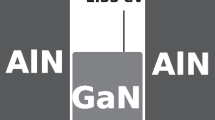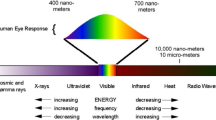Abstract
The optical properties of magneto-plasmonic nanostructures are a current subject of research with fast-growing experimental and theoretical activities. The coexistence of iron (Fe) and noble metal (Ag/Au) nanoparticles in the same nanostructure is interesting for biomedical applications, as well as low-cost photonic devices. In this article, we investigated the optical response of Ag–Fe, Au–Fe, and Ag–Fe–Au bimetallic and trimetallic alloy nanostructures as a function of size, shape, and composition by using discrete dipole approximation (DDA) method. We observed that the localized surface plasmon resonance (LSPR) peak position in considered alloy nanostructures is enhanced by changing the particle size and shape, further strongly affected by rectangular shape in comparison to prolate, cube, triangular, and spherical shapes. The absorption and scattering spectra are found between 200 and 647 nm wavelength ranges and can be tuned in UV-visible-near-infrared region of the electromagnetic spectrum in accordance with desired applications. It has been found that the rectangular shape nanostructure show enhancement to LSPR peaks and their corresponding efficiencies in comparison to prolate, cube, triangular, and spherical shapes. The effect of size and shape on relative efficiency has also been studied. An increasing number of peaks appear in the optical spectra of considered nanostructures with higher gold concentration and show a broadening of LSPR peaks. Furthermore, it has been found that the optical response of alloys can be enhanced by varying the metal composition. The comparison of the considered nanostructure of different shape and size shows the LSPR at λmax have the ordering as rectangular > prolate > cube > triangular> spheres. The obtained results indicate the potential use of suitable magnetic-plasmonic nanostructures in medical diagnostics and biological imaging.













Similar content being viewed by others
References
Wu A, Ou P, Zeng L (2010) Biomedical applications of magnetic nanoparticles. Nano 5:245–270
Son SJ, Reichel J, He B, Schuchman M, Lee SB (2005) Magnetic nanotubes for magnetic-field-assisted bioseparation, bio-interaction, and drug delivery. J Am Chem Soc 127:7316–7317
Rivas J, Banobre-Lopez M, Pineiro-Redondo Y, Rivas B, Lopez-Quintela MA (2012) Magnetic nanoparticles for application in cancer therapy. J Magn Magn Mater 324:3499–3502
Hirsch R, Katz E, Willner I (2000) Magneto-switchable bioelectrocatalysis. J Am Chem Soc 122:12053–12054
Liu Z, Liu Y, Yang H, Yang Y, Shen G, Yu R (2005) A phenol biosensor based on immobilizing tyrosinase to modified core-shell magnetic nanoparticles supported at a carbon paste electrode. Anal Chim Acta 533:3–9
Gao J, Gu H, Xu B (2009) Multifunctional magnetic nanoparticles: design, synthesis, and biomedical applications. Acc Chem Res 42:1097–1107
Babes L, Denizot B, Tanguy G, Le Jeune JJ, Jallet P (1999) Synthesis of iron oxide nanoparticles used as MRI contrast agents: a parametric study. J Colloid Interface Sci 212:474–482
Jiang W, Yang HC, Yang SY, Horng HE, Hung JC, Chen YC, Hong CY (2004) Preparation and properties of superparamagnetic nanoparticles with narrow size distribution and biocompatible. J Magn Magn Mater 283:210–214
Armelles G, Cebollada A, Garcia-Martin A, Montero-Moreno JM, Waleczek M, Nielsch K (2012) Magneto-optical properties of core-shell magneto-plasmonic Au–Cox Fe3–x O4 nanowires. Langmuir 28:9127–9130
Bonanni V, Bonetti S, Pakizeh T, Pirzadeh Z, Chen J, Nogues J, Dmitriev A (2011) Designer magnetoplasmonics with nickel nano ferromagnets. Nano Lett 11:5333–5338
Mayer KM, Hafner JH (2011) Localized surface plasmon resonance sensors. Chem Rev 111:3828–3857
Wu H, Wang P, He H, Jin Y (2012) Controlled synthesis of porous Ag/Au bimetallic hollow nanoshells with tunable plasmonic and catalytic properties. Nano Res 5:135–144
Atwater HA, Polman A (2010) Plasmonics for improved photovoltaic devices. Nat Mater 9:205–213
Jain PK, Huang X, El-Sayed IH, El-Sayed MA (2008) Noble metals on the nanoscale: optical and photothermal properties and some applications in imaging, sensing, biology, and medicine. Acc Chem Res 41:1578–1586
Berthelot J, Bouhelier A, Huang C, Margueritat J, Colas-des-Francs G, Finot E, Baudrion AL (2009) Tuning of an optical dimer nanoantenna by electrically controlling its load impedance. Nano Lett 9:3914–3921
Khatua S, Chang WS, Swanglap P, Olson J, Link S (2011) Active modulation of nanorod plasmons. Nano Lett 11:3797–3802
Sun Y, Jiang L, Zhong L, Jiang Y, Chen X (2015) Towards active plasmonic response devices. Nano Res 8:406–417
Maier SA (2007) Plasmonics: fundamentals and applications. Springer Science & Business Media
Bohren CF, Huffman DR (1983) Absorption and scattering by a sphere. Wiley-VCH Verlag GmbH:82–129
Sekhon JS, Verma SS (2011) Refractive index sensitivity analysis of Ag, Au, and Cu nanoparticles. Plasmonics 6:311–317
Bansal A, Sekhon JS, Verma SS (2014) Scattering efficiency and LSPR tunability of bimetallic Ag, Au, and Cu nanoparticles. Plasmonics 9:143–150
Stafford S, Serrano Garcia R, Gun’ko YK (2018) Multimodal magnetic-plasmonic nanoparticles for biomedical applications. Appl Sci 8:97
Armelles G, Cebollada A, Garcia-Martin A, Gonzalez MU (2013) Magnetoplasmonics: combining magnetic and plasmonic functionalities. Adv Opt Mater 1:10–35
Kelly KL, Coronado E, Zhao LL, Schatz GC (2003) The optical properties of metal nanoparticles: the influence of size, shape, and dielectric environment. J Phys Chem B 107:668–677
Noguez C (2007) Surface plasmons on metal nanoparticles: the influence of shape and physical environment. J Phys Chem C 111:3806–3819
Bhatia P, Verma SS, Sinha MM (2017) Optical response of coated iron oxide (s) nanoparticles towards biomedical applications. Am J Opt Photon 5:67–72
Bhatia P, Verma SS, Sinha MM (2018) Size-dependent optical response of magneto-plasmonic core-shell nanoparticles. Adv Nano Res 1:1–13
Draine BT, Flatau PJ (1994) Discrete-dipole approximation for scattering calculations. JOSA A 11:1491–1499
Gedney SD (2011) Introduction to the finite-difference-time-domain (FDTD) method for electromagnetics. Synthesis Lectures on Computational Electromagnetics, Morgen & Claypool Publishers, UK
Monk P (2003) Finite element methods for Maxwell’s equations. Oxford University Press
Draine BT, Flatau PJ (2008) Discrete-dipole approximation for periodic targets: theory and tests. J Opt Soc Am A 25:2693–2703
Johnson PB, Christy RW (1972) Optical constants of the noble metals. Phys Rev B 6:4370–4379
Johnson PB, Christy RW (1974) Optical constants of transition metals: Ti, V, Cr, Mn, Fe, Co, Ni, and Pd. Phys Rev B 9:5056–5070
Messina E, D’Urso L, Fazio E, Satriano C, Donato MG, D’Andrea C, Neri F (2012) Tuning the structural and optical properties of gold/silver nano-alloys prepared by laser ablation in liquids for optical limiting, ultra-sensitive spectroscopy, and optical trapping. J Quant Spectrosc Radiat Transf 113:2490–2498
Henkel A, Schubert O, Plech A, Soonnichsen C (2009) Growth kinetic of a rod-shaped metal nanocrystal. J Phys Chem C 113:10390–10394
Tan KS, Cheong KY (2013) Advances of Ag, Cu, and Ag–Cu alloy nanoparticles synthesized via chemical reduction route. J Nanopart Res 15:1537
Amendola V, Saija R, Marago OM, Iati MA (2015) Superior plasmon absorption in iron-doped gold nanoparticles. Nanoscale 7:8782–8792
Cobley CM, Chen J, Cho EC, Wang LV, Xia Y (2011) Gold nanostructures: a class of multifunctional materials for biomedical applications. Chem Soc Rev 40:44–56
Xia Y, Xiong Y, Lim B, Skrabalak SE (2009) Shape-controlled synthesis of metal nanocrystals: simple chemistry meets complex physics. Angew Chem 48:60–103
Ashkarran AA, Derakhshi M (2015) The effect of FeCl 3 in the shape control polyol synthesis of silver nanospheres and nanowires. J Clust Sci 26:1901–1910
Ashkarran AA, Daemi S (2016) Tuning the plasmon of metallic nanostructures: from silver nanocubes toward gold nanoboxes. Plasmonics 11:1011–1017
Ashkarran AA, Bayat A (2013) Surface plasmon resonance of metal nanostructures as a complementary technique for microscopic size measurement. Int Nano Lett 3:1–10
Ashkarran AA, Daemi S, Derakhshi M (2016) Destructive effect of solar light on morphology of colloidal silver nanocubes. Colloid Journal 78:577–585
Ashkarran AA (2016) The effect of visible-light intensity on shape evolution and antibacterial properties of triangular silver nanostructures. Opt Mater 58:454–460
Acknowledgments
The author, Pradeep Bhatia, thanks B.T. Draine and P.J. Flatau for the use of their DDA code, DDSCAT 7.3. Pradeep Bhatia is also very thankful to S.L.I.E.T. Longowal for providing financial assistance towards his Ph.D.
Author information
Authors and Affiliations
Corresponding authors
Electronic Supplementary Material
ESM 1
(DOCX 307 kb)
Rights and permissions
About this article
Cite this article
Bhatia, P., Verma, S.S. & Sinha, M.M. Optical Properties Simulation of Magneto-Plasmonic Alloys Nanostructures. Plasmonics 14, 611–622 (2019). https://doi.org/10.1007/s11468-018-0839-7
Received:
Accepted:
Published:
Issue Date:
DOI: https://doi.org/10.1007/s11468-018-0839-7




